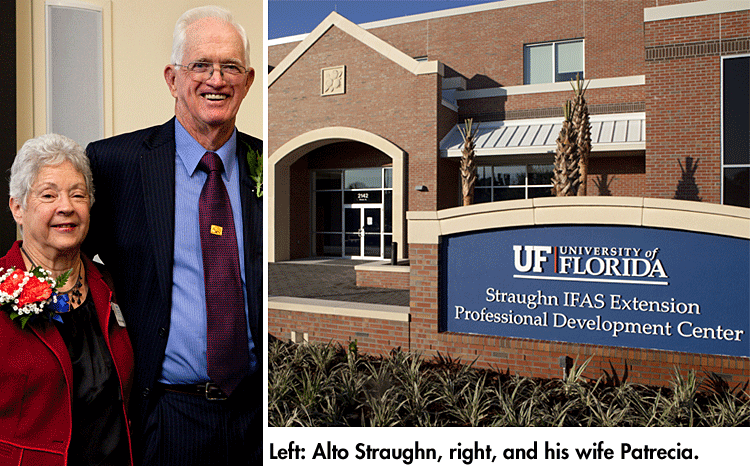Florida blueberry pioneer is recognized for his contributions
THE UNIVERSITY OF FLORIDA’S Institute of Food and Agricultural Sciences prides itself on growing blueberries all over the state. More than 95 percent of the state’s 5,000 acres of the fruit are planted in cultivars developed by UF/IFAS.
Blueberries have also helped us with a crucial crop we grow on campus in Gainesville — talent. In fact, I like to call our training center “The House That Blueberries Built.” Three years ago, we opened the Straughn IFAS Extension Professional Development Center. The name comes, of course, from Florida blueberry pioneer Alto Straughn and his wife Patrecia.
Without their financial support, the building wouldn’t be there. The 35,000 guests who have attended events at the center so far would have had to look elsewhere to get better at their jobs or maybe even lost opportunities to do so.
We’ve had nearly 500 events at the Straughn Center, from brief in-service trainings to multi-day conferences. In July, we’ve scheduled a small special event for Alto and Patrecia.
Although we named the building for them, we never stamped it with anything that gives visitors a sense of who the Straughns are. So, we’re installing a plaque with a photo of the Straughns and a brief biography of their remarkable story.
Alto has achieved so much, in part because he has always lived a bit of a double life. In the 1950s, as a UF undergraduate, he double-majored. Then he undertook dual careers as an IFAS Extension administrator and as a farmer.
What really sets him apart is his double identity as a beneficiary of IFAS and one of its most beloved benefactors. In 1982, the Straughns bought a bankrupt dairy farm and decided it would be a good place to plant blueberries. It became a proving ground for new types of blueberries.
Working closely with IFAS researchers, Alto led a change in blueberry cultivation from rabbiteye varieties to Southern highbush berries. He demonstrated they could be grown profitably on a large scale. It helped build markets for Florida blueberries. All the while, he shared what he knew with everyone, whether it was employees, IFAS Extension agents and researchers, or even competitors.
The result has been an industry that grew out of almost nothing over the past 30 years. Alto’s innovations in the areas of freeze protection, pollination, harvesting, pine-bark beds, plastic mulch, tunnels, and irrigation led to practices now in common use on Florida farms.
He did so well with blueberries that he is in the fortunate position of being able to give back financially. He has done so repeatedly. He and Patrecia have funded the work of UF/IFAS graduate students. They were the lead supporters of our Flavors of Florida event this year that celebrated our new Plant Innovation Center. They gave generously to help make the Straughn Center possible.
The financial support has been invaluable, but he has also shared his knowledge. He continues to offer part of his land to UF/IFAS researchers for on-farm breeding trials, an in-kind donation worth hundreds of thousands of dollars. He opens his farm for field visits and spends time showing visitors around and sharing what he’s learned over the decades.
It’s likely that giving back, through service to the industry on various boards and advice to countless individuals, is what put him in the Florida Agricultural Hall of Fame and earned him the Commissioner’s Ag-Environmental Leadership Award.
Alto has been a great embodiment of the three-fold land-grant mission. He gave Extension 31 years of service as an administrator. As a farmer and IFAS research collaborator, he developed new scientific knowledge that built an industry. Then he helped build a place of teaching and learning in a center that bears his name.
He has a brick-and-mortar legacy of giving back to the land-grant institution that gave much to him over the years. Now, he and Patrecia will have the plaque, too, to make that connection more explicitly.
It’s a modest way we at IFAS say “Thank you” to the Straughns. We hope the plaque will encourage others to develop the same close relationship with UF/IFAS teaching, research, and Extension to continue improving both the industry and the university.
CREDIT
article by JACK PAYNE
ABOUT THE AUTHOR: Jack Payne is the University of Florida’s senior vice president for agriculture and natural resources and leader of UF’s Institute of Food and Agricultural Sciences.

